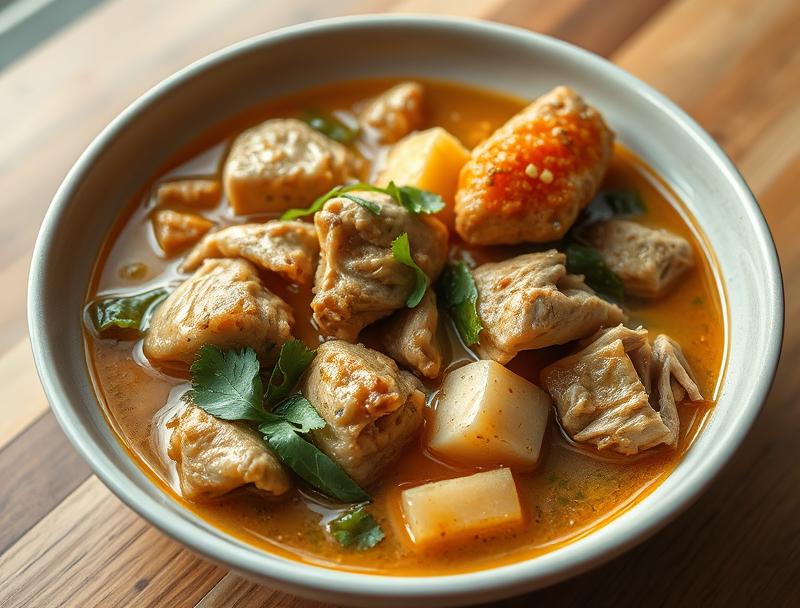Chicken Stew
Introduction
Imagine a warm, comforting dish that’s not only easy to make but also packed with flavor, using everyday ingredients you likely have in your pantry. Chicken stew is one of those versatile meals that can be enjoyed any time of the year, whether you’re looking for a hearty meal on a chilly evening or a simple, satisfying lunch. The beauty of chicken stew lies in its ability to bring people together, with its aromatic flavors and tender textures that are sure to delight both kids and adults alike. In this recipe, we’ll explore how to create a delicious chicken stew that’s both nourishing and mouth-watering, using a combination of chicken, vegetables, and aromatic spices.
Why This Works
- Flavor balance and ingredient accessibility: This recipe strikes a perfect balance between the richness of the chicken, the earthiness of the vegetables, and the depth of the spices, making it accessible to a wide range of tastes and dietary preferences.
- Ease of preparation: The steps involved in making this chicken stew are straightforward and easy to follow, requiring minimal cooking expertise and making it a great option for beginners or those short on time.
- Impressive results with minimal effort: Despite its simplicity, this chicken stew recipe yields impressive results, with each bite a testament to the harmony of flavors and textures that can be achieved with a little creativity and minimal effort.
Ingredients
- 1 1/2 pounds boneless, skinless chicken breast or thighs, cut into 1-inch pieces
- 2 tablespoons olive oil
- 1 large onion, chopped
- 3 cloves garlic, minced
- 2 medium carrots, peeled and chopped
- 2 medium potatoes, peeled and chopped
- 1 large red bell pepper, chopped
- 1 can (14.5 oz) diced tomatoes
- 2 cups chicken broth
- 1 teaspoon dried thyme
- 1/2 teaspoon dried rosemary
- Salt and pepper, to taste
- 2 tablespoons all-purpose flour (optional)
- Fresh parsley or thyme, chopped (for garnish)
Instructions
- Step 1: Preparation – Begin by chopping all the vegetables (onion, garlic, carrots, potatoes, and bell pepper) and measuring out the spices and broth. This step ensures that you have everything ready to go, making the cooking process smoother and more efficient.
- Step 2: Searing the Chicken – Heat the olive oil in a large Dutch oven or pot over medium-high heat. Add the chicken and cook until browned on all sides, about 5-7 minutes. Remove the chicken from the pot and set it aside. This step is crucial for developing the flavor and texture of the chicken.
- Step 3: Softening the Vegetables – Reduce the heat to medium and add the chopped onion to the pot. Cook, stirring occasionally, until the onion is softened and translucent, about 5 minutes. Add the garlic, carrots, potatoes, and bell pepper, and continue to cook for another 5 minutes, stirring occasionally, until they begin to soften.
- Step 4: Combining the Ingredients – Add the browned chicken back into the pot, along with the diced tomatoes, chicken broth, thyme, rosemary, salt, and pepper. Stir well to combine, then bring the mixture to a boil. Reduce the heat to low, cover the pot, and simmer, stirring occasionally, until the chicken is cooked through and the vegetables are tender, about 20-25 minutes.
- Step 5: Thickening (Optional) – If you prefer a thicker stew, mix the flour with a little water until smooth, then stir it into the stew. Continue to simmer for a few more minutes, until the stew has thickened to your liking.
- Step 6: Serving – Serve the chicken stew hot, garnished with chopped fresh parsley or thyme. You can serve it on its own or with some crusty bread or over mashed potatoes for a more filling meal.
Handy Tips
- For a richer flavor, use chicken broth instead of water and add a bit of red wine if you like.
- Consider using different types of potatoes, like Yukon Golds, for a buttery flavor.
- Don’t overcook the chicken and vegetables; they should be tender but still retain some texture.
- If using flour to thicken, make sure to cook it for a minute or two to remove any raw flour taste.
Heat Control
Heat control is crucial in making a perfect chicken stew. After browning the chicken and softening the vegetables, reduce the heat to a simmer to cook the stew gently. This low heat helps in tenderizing the chicken and vegetables without burning the stew. Ideally, the stew should simmer at a temperature of around 180°F to 190°F (82°C to 88°C), and it should cook for about 20-25 minutes, or until the chicken is cooked through and the vegetables are tender. Signs of doneness include the chicken reaching an internal temperature of 165°F (74°C) and the vegetables being easily pierced with a fork.
Crunch Factor
The crunch factor in chicken stew comes from the texture of the vegetables. To achieve a nice balance of tender and crunchy textures, don’t overcook the vegetables. The carrots, potatoes, and bell pepper should be tender but still crisp. If you prefer a softer texture, you can cook them for a few more minutes. Additionally, serving the stew with some crusty bread or crunchy crackers can add a satisfying crunch to the meal.
Pro Kitchen Tricks
- Use a mix of chicken breast and thighs for more complex flavors and textures.
- Acidity, like a squeeze of fresh lemon juice, can brighten the flavors of the stew.
- For easier cleanup, cook the stew in a Dutch oven, which can go from stovetop to oven and then be served directly from the pot.
Storage Tips
- Leftover chicken stew can be refrigerated for up to 3 days or frozen for up to 3 months. When reheating, make sure the stew reaches a temperature of 165°F (74°C) to ensure food safety.
- Use airtight, shallow containers to cool the stew quickly and prevent bacterial growth.
- When freezing, consider portioning the stew into individual servings for easier thawing and reheating.
Gift Packaging Ideas
If you’re considering gifting your chicken stew, a thoughtful and practical way to do so is by packaging it in a decorative, airtight container that can be reheated. You could use a mason jar or a ceramic container, topping it with a ribbon or a gift tag that includes reheating instructions. Another idea is to pair the stew with some crusty bread or crackers and a side salad, creating a complete meal gift basket that’s both nourishing and delicious.
Flavor Variations
- Different spices: Consider adding a pinch of cumin for a smoky flavor or some paprika for a spicy kick.
- Creative toppings: Add some freshness with chopped herbs, a dollop of sour cream, or some grated cheese.
- Ingredient swaps: Use beef or pork instead of chicken for a different protein, or substitute the potatoes with sweet potatoes for a sweeter flavor.
Troubleshooting
- Texture problems: If the stew becomes too thick, add a bit of broth or water. If it’s too thin, simmer it for a few more minutes or add a thickening agent like flour or cornstarch.
- Ingredient replacements: If you don’t have thyme, you can substitute it with oregano or basil. For a gluten-free option, use gluten-free flour for thickening.
- Over/undercooking signs: Check the chicken for an internal temperature of 165°F (74°C) and the vegetables for tenderness. If the stew is undercooked, continue to simmer until it reaches the desired doneness. If it’s overcooked, consider adding more broth or serving it with a side that can absorb some of the excess moisture.
FAQs
- Can I freeze it? Yes, chicken stew can be frozen for up to 3 months. It’s best to freeze it in airtight, shallow containers or freezer bags, making sure to press out as much air as possible before sealing.
- Is it gluten-free? The basic recipe is gluten-free, but be cautious with the broth and any thickening agents you might use. Always choose gluten-free options to accommodate dietary restrictions.
- Can I double the recipe? Yes, you can easily double or triple the recipe if you’re serving a larger crowd. Just make sure you have a large enough pot and adjust the cooking time slightly, as a larger volume of stew may take a bit longer to cook through.
Conclusion
Making a delicious chicken stew is not only about following a recipe but also about creating a dish that brings warmth and comfort to those who enjoy it. With its rich flavors, tender textures, and the ease of preparation, this chicken stew recipe is perfect for any occasion, whether it’s a family dinner, a casual gathering, or a special event. Feel free to experiment with different spices and ingredients to make the recipe your own, and don’t hesitate to share your creations with friends and family. The joy of cooking lies in the sharing and the love that goes into every dish, and a hearty, homemade chicken stew is the perfect way to spread that love and warmth.

